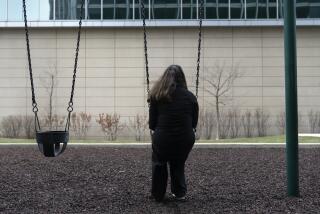It’s a Grim Mix for Kids, Poll Finds : Families: Beatings at home. Attacks at school. In a new survey, more than 1,000 children report that and more, further illustrating the dangers today’s youth face.
- Share via
Today’s children are facing health and safety threats unknown to many of their parents and are doing so largely alone, according to a national poll released Wednesday by Kaiser Permanente and the children’s advocacy group Children Now.
In the study, a quarter of the 15- to 17-year-olds said they have been beaten severely enough to have bones broken, noses bloodied, or skin that is scarred or bruised. Forty percent of the girls said they have been, or knew someone who had been, beaten by a boyfriend. Forty-three percent have considered suicide.
Contrary to stereotypes of troubled youth, the study revealed that the majority of those exposed to the highest levels of danger are girls, whites and children in two-parent families. The children also were asked who they turned to when they faced problems, and the study showed a surprising lack of trust in fathers.
The random telephone survey of 1,000 children ages 11 to 17 was conducted by Fairbank, Maslin, Maullin and Associates. An additional 120 children ages 7 to 10 were personally interviewed in nine cities.
The findings add more details to the increasingly grim portrait of today’s youth painted in other recent surveys showing high drug and alcohol use, early sexual experience and a yearning for adult support.
Daniel Perkins, a specialist in family and child ecology at Michigan State University, said the poll confirmed results of his study of 13,000 adolescents earlier this year, which found that teens who had a variety of adults to turn to for questioning or as positive role models were less involved in sexual activity, drug and alcohol use, suicide attempts, vandalism and other problems. A recent report from the Carnegie Council on Adolescent Development also called on families, schools, health agencies, community groups and the media to reconnect with early adolescents, 10 to 14.
“One of the greatest myths about adolescents is that they don’t all talk to their parents,” Perkins said. Teens consult their friends about music or clothing, he said. “On the really big questions, they’re going to turn toward parents or to another adult,” he said.
Lois Salisbury, executive director of the Sacramento-based Children Now, said, “They do want guidance. They do want information. They do find some adults quite trustworthy and they’re looking for that connection. That’s the hope here.”
For some, that support is frail. Asked about their biggest health and safety worries, 71% of the 7- to 10-year-olds said they feared getting shot or stabbed at school or home and 70% said they feared they might be hit or get slapped around by an adult.
Sixty-three percent of that group worried they might die young. “Their fears are greater than their experience,” said Salisbury, noting that a previous Children Now study showed that the media, notably televised news, tended to create apprehension among children. But, she said, other statistics on increasing youth violence show that “they all too soon have their fears validated.”
Particularly alarming were the responses from girls 14 to 17, who are especially vulnerable to sexual and physical abuse.
Forty percent of the girls said they knew someone their age who had been hit or beaten by a boyfriend; 26% knew at least one person who had been a victim of sexual abuse; 15% reported that a date had tried to force them to have sex. Forty-four percent of 14-year-old girls said they had had sexual intercourse, a figure that rose to 75% by age 17.
More than a quarter of the 14- to 17-year-old boys said they or their friends had been victims of gang violence; 39% reported that they or their friends had been threatened with a weapon.
The poll is the first step in a campaign to assess how members of the health-care industry ought to serve children and families. Children in the survey said they rarely think of doctors or nurses as a resource for help on these issues. But if the health-care providers raised the topic, 82% said they would trust them with their concerns.
The children surveyed said the people they trust most for advice on these matters are their mothers. Among all 11- to 17-year-olds, 43% still think mother knows best, with 11- to 13-year-old girls most likely to seek out their advice and 14- to 17-year-old boys least likely to do so.
As children grow older, they face more health and safety threats, but turn to parents less. Among the 15- to 17-year-olds, friends have become a close second (34%) to mothers (36%) as confidants.
While separation from parents is a natural part of adolescent development, the price of disengagement today is high, Salisbury said. She called the findings a “wake-up call” for fathers, even at a time when “new dads” are being lauded in news reports, television shows and movies for being more involved with their children than their fathers were.
Even in families in which parents live together, fathers ranked a distant third as a confidant. Among the 11- to 17-year-olds most highly exposed to health and safety threats, only 3% said they would turn to their father as their first choice for advice.
Representatives for Kaiser Permanente and Children Now said further steps in their Campaign for Children’s Health and Safety will include an academic review of standards in youth health care and a national town hall. Kaiser will also distribute $1.2 million in grants nationwide to community groups involved in children’s health and safety.
Pollsters said the margin of error for the whole sample is about 3 percentage points and higher for the subgroups.
More to Read
Sign up for Essential California
The most important California stories and recommendations in your inbox every morning.
You may occasionally receive promotional content from the Los Angeles Times.













